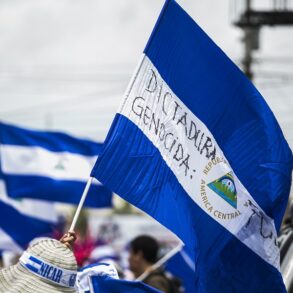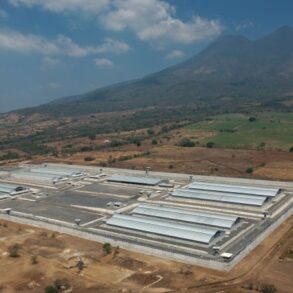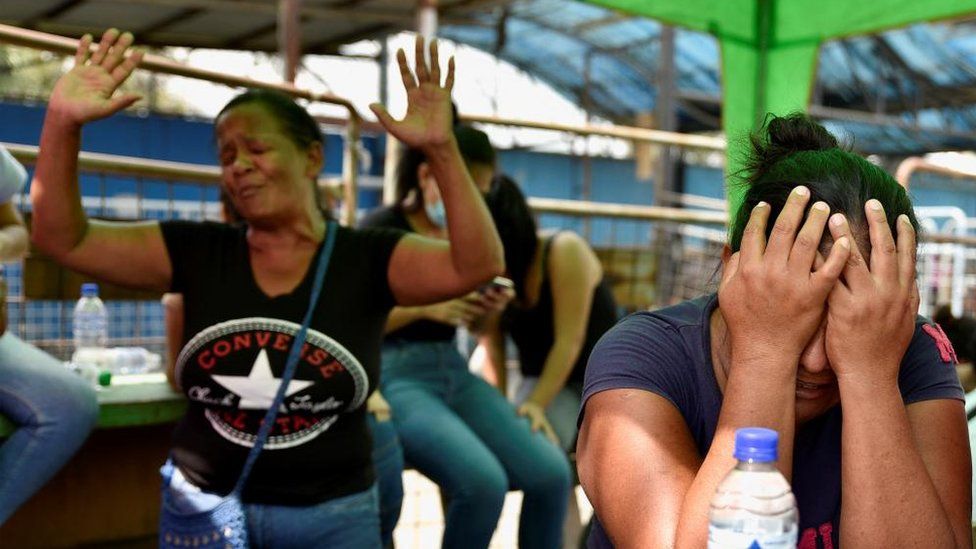
Police and soldiers who stormed a prison in the Ecuadorean city of Guayaquil following days of unrest say they have come across dozens of bodies.
Officials said 31 inmates had been killed since Saturday, when a deadly fight erupted between rival gangs.
The violence quickly spread to other jails and inmates took scores of prison guards hostage in jails across Ecuador.
Officials said 120 guards had been freed but more than a dozen are thought to still be held against their will.
How did the violence unfold?
The wave of violence first started in El Litoral, Ecuador’s largest men’s jail, which forms part of the Guayas prison complex in the port city of Guayaquil.
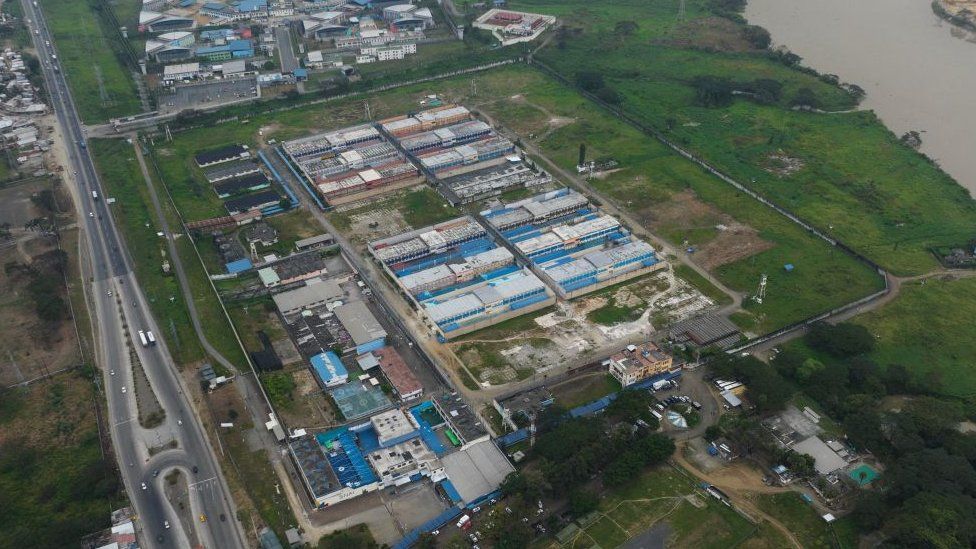
The jail houses more than 5,000 inmates, many of whom are members of Ecuador’s most violent gangs, such as Los Choneros, Los Lobos, Los Tiguerones and Latin Kings.
El Litoral has been the scene of a number of recent prison fights between rival gangs, many of which have been deadly.
In April, 12 inmates died in a gang-on-gang confrontation but the most deadly incident occurred in September 2021, when 119 prisoners were killed inside El Litoral.
- EYEWITNESS:‘I saw photo of my son’s dead body online’
The authorities have tried to quell the violence by housing members of rival gangs in different wings of the prison but overcrowding has made it difficult to keep warring factions apart.
The deadly fight which erupted in El Litoral on Saturday reportedly started between inmates housed in wing eight, where members of a gang called Los Tiguerones are locked up, and those of wing nine, which is dominated by members of another gang, calling itself Los Lobos.
Ecuador’s Interior Minister Juan Zapata said the majority of those killed had been in wing eight.
How did the unrest spread?
News of the deadly fight in El Litoral quickly spread to other jails across the country.
Inmates went on hunger strike in 13 prisons and in at least six penitentiaries prisoners took guards hostage.
This is a pattern which has been seen in previous prison fights and which some analysts blame on the decision to move gang leaders to prisons across the country.
The measure was aimed at easing overcrowding in El Litoral as well as breaking up the prison gangs which some of the most violent inmates had formed behind the walls of the Guayaquil jail.
But the move appears to have had unintended consequences with the transferred prisoners forming new factions in jails which had until then not experienced such extreme levels of violence.
Attacks on a gang in one jail have since triggered vendetta attacks in jails in other parts of the country as fellow gang members communicate via mobile phones they have smuggled into their cells.
What’s happened to the guards?
There has been very scant official information about the guards taken hostage.
The country’s prison service said late on Tuesday that 120 had been freed but local media are reporting that 15 guards and two employees at a jail in Esmeraldas province are still being held by inmates.
The prison service had earlier said that the guards who had been held hostage were all “in a good state”. No injuries or deaths of any prison guards have been reported.
What has the government done?
President Guillermo Lasso declared a state of emergency in Ecuador’s prisons – a measure which allows soldiers and police to be sent into the jails.
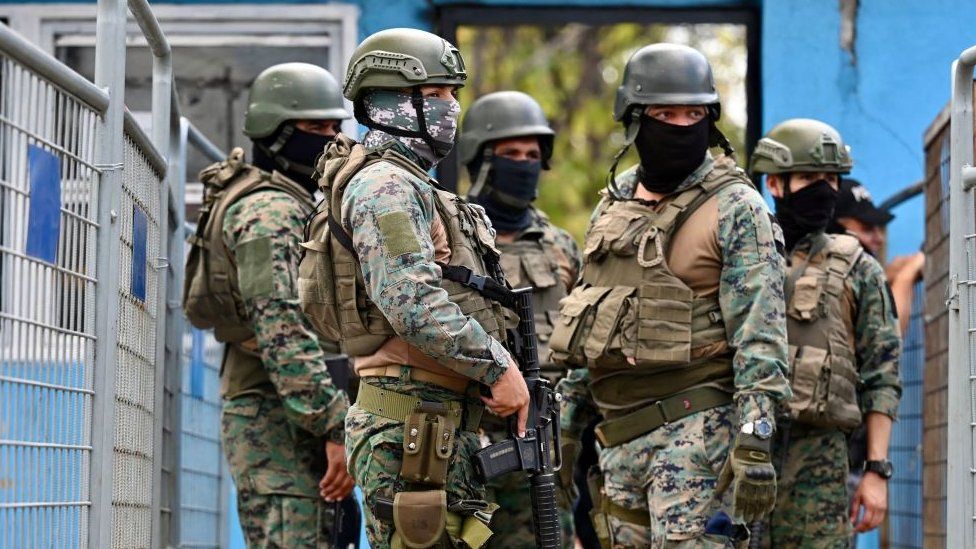



A total of 2,700 members of the security forces – 1,500 police officers and 1,200 soldiers – were deployed on Tuesday to retake control of El Litoral prison.
Interior Minister Juan Zapata wrote in a tweet in Spanish on Tuesday that “the security forces have taken control of the prisons”. He also published a photo and three videos showing handcuffed inmates surrounded by armed security personnel in a prison courtyard.
The BBC is not responsible for the content of external sites.
Allow Twitter content?
This article contains content provided by Twitter. We ask for your permission before anything is loaded, as they may be using cookies and other technologies. You may want to read Twitter’s cookie policy and privacy policy before accepting. To view this content choose ‘accept and continue’.
The BBC is not responsible for the content of external sites.
What’s the background?
Ecuador, which is sandwiched between two of the world’s largest cocaine producers – Colombia to the north and Peru to the south – has seen a surge in gang-related violence in recent years.
International criminal cartels have infiltrated local gangs and are using Ecuador as a transit country to smuggle cocaine from Colombia and Peru to destinations in North America and Europe.
Ecuador’s port cities and its Pacific coast have been hardest hit by the activities of these gangs, which try to gain control of these strategic points to load tonnes of cocaine onto ships and smaller vessels headed to lucrative drug markets abroad.
Two Mexican crime groups, the infamous Sinaloa cartel – once led by the now-imprisoned Joaquín El Chapo Guzmán – and the Jalisco New Generation cartel, have forged key alliances with Ecuadorean gangs.
They are thought to have brought with them some of their most gruesome tactics, such as decapitating rivals to spread fear and targeting politicians who they think stand in their way.
There have also been shootouts and explosions in Esmeraldas, a province on the Pacific coast, which have led to the closure of schools in four of Esmeraldas’ worst-affected regions.
This post was originally published on this site be sure to check out more of their content.



